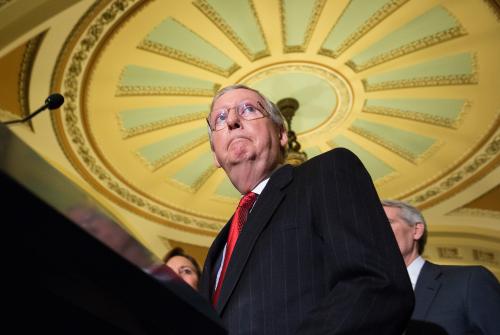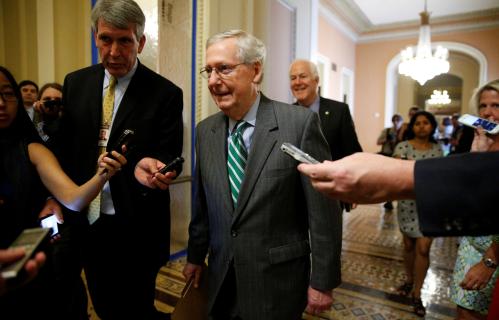This article originally appeared on Real Clear Health on July 24, 2017.
The high decibel fight in the Senate over Medicaid is one more example—did we need more?—of why lasting changes in social programs require thoughtful legislative deliberation leading to bipartisan consensus. There should be hearings to gather input from all sides and serious debate in committees as well as on the floor. If one party rams through big changes in any program as important as Medicaid, the other party will demonize the result. In the case of Medicaid cuts, arousing public outrage won’t be hard. Individuals and families, state governments, rural hospitals and other health providers will all be vocal about their plight. One wonders why either party would seek such opprobrium when they could be working together on sensible Medicaid reform.
In defending their Medicaid cuts, Republicans invoke two valid points with which most Democrats agree. First, federal entitlements, especially the big health entitlements, Medicaid and Medicare, are on an unsustainable path. They drive projected growth in federal spending as the population ages and health care becomes more expensive. Policies to reduce the future growth of Medicare and Medicaid—along with Social Security and tax reform—have to be part of any effective effort to keep the debt from growing faster than the economy and contain the burden of debt service as interest rates rise.
Second, Medicaid is a particularly complex web of federal subsidies that serve multiple purposes and diverse populations. It dominates state budgets, often driving out other needed spending. It has complex, restrictive rules. Its joint state-federal responsibility clouds accountability and federal matching of state spending arguably reduces incentives for state efficiency. In short, Medicaid badly needs rethinking and restructuring.
So, if Medicaid has to be part of entitlement reform and needs restructuring, aren’t Republicans taking a good first step in replacing the Affordable Care Act (ACA) with a law that makes drastic cuts in Medicaid? No, they are taking the worst possible step, both politically and substantively.
Senator Pat Toomey (R-PA) describes Medicaid growth as “out of control,” noting that Medicaid spending has grown twice as fast as the economy since its creation in the mid-1960s. It is true that Medicaid has gone from .49 percent of GDP to 3.02 percent between 1970 and 2015. In the same period, Medicare spending has grown from .71 percent to 3.58 percent of GDP, and private health spending from 1.44 percent to 5.94 percent.
Medicaid is not out of control; it is health spending, which now accounts for about 18 percent of all spending. Americans are devoting increasing portions of our total resources to health care because medical interventions help patients more than they did in the old days. We all want care, but we have a costly, wasteful, fragmented system for delivering it. We need to accelerate efforts to produce care more efficiently and change our behavior to stay healthier, but cutting care for the neediest is a terrible place to start.
We need to accelerate efforts to produce care more efficiently and change our behavior to stay healthier, but cutting care for the neediest is a terrible place to start.
Medicaid actually serves comparable patients less expensively than private coverage, because of Medicaid’s low reimbursement to providers and increasing use of managed care. In recent decades, Medicaid spending growth has resulted almost entirely from efforts to increase insurance coverage by expanding Medicaid to new groups—pregnant women and children in the 1990’s and most recently low-income adults without dependents under the ACA. In general, Medicaid’s costs per enrollee have grown more slowly than Medicare or private payers. The ACA expansion population surprised the estimators with higher than expected need for services, but this need is expected to decrease over time. If the objective is to rein in health spending growth (or entitlement growth), Medicaid should be part of the conversation, but not the lead focus.
There are plenty of sensible Medicaid reforms that could attract both Republicans and Democrats. One approach would be to recognize that Medicaid is actually two programs. One provides long-term care and support services for the elderly and disabled. These enrollees represented about 21 percent of the Medicaid population in 2014, but generate 61 percent of total program costs. Increasingly Medicaid pays for services that allow elderly and disabled people to stay in their own homes for greater satisfaction at less cost. It could make sense to relieve states of part or all of the cost of serving the elderly and disabled by shifting them to Medicare, which serves many of the same people, but such a shift would greatly increase Medicare costs.
The rest of Medicaid beneficiaries are low-income children and adults, including adults without dependents now covered as a result of expansion under the ACA. Many low-income adults now on Medicaid are employed but not in steady jobs with health benefits. Their incomes fluctuate so that they are sometimes eligible for Medicaid and sometimes when they are doing well, for subsidies to buy private health insurance. It would make sense to consider combining Medicaid spending for low-income adults and their children with subsidies for buying private health insurance, creating a single program that would ensure continuity of coverage and be simpler to administer—or at least to allow states try the combination.
Indeed, the most basic question about Medicaid is what role it should play in expanding health insurance coverage to the uninsured. Expanding eligibility for Medicaid, as the ACA did, is a relatively inexpensive option for increasing health insurance coverage quickly (Republicans admit this aspect of the ACA worked as intended). The market-oriented approach of subsidizing low-income households to purchase private insurance can also work, but it is more expensive, because providers demand higher compensation, and it is challenging to find a way to induce young, healthy people to buy into the insurance pool without a mandate.
Reaching a consensus on the role of Medicaid in financing health care requires thoughtful deliberation, bipartisan negotiation and two-party buy-in not possible in the context of a go-it-alone scramble to pass a reconciliation bill. With any luck, Republicans will fail to pass their one-party solution and be forced to seek common ground with Democrats in crafting a more durable Medicaid reform. If so, vulnerable Republican candidates may be glad they have constructive health reform to defend—and faith in our democracy will be strengthened by a demonstration that the policymaking process is not totally broken.
The Brookings Institution is committed to quality, independence, and impact.
We are supported by a diverse array of funders. In line with our values and policies, each Brookings publication represents the sole views of its author(s).






Commentary
Op-edRepublicans’ wrong approach to tackling Medicaid
July 25, 2017